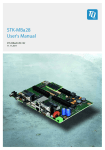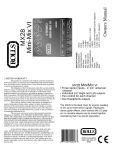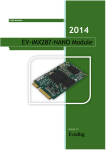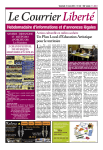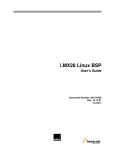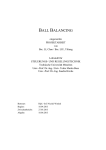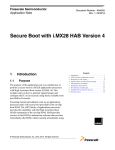Download TQMa28 User's Manual
Transcript
TQMa28 User's Manual TQMa28 UM 104 28.03.2013 User's Manual l TQMa28 UM 104 l © 2013 by TQ-Group Page i Table of contents 1. 1.1 1.2 1.3 1.4 1.5 1.6 1.7 1.8 1.9 1.10 2. 3. 3.1 3.1.1 3.1.2 3.1.2.1 3.1.2.2 4. 4.1 4.1.1 4.1.1.1 4.1.1.2 4.2 4.2.1 4.2.1.1 4.2.1.2 4.2.1.3 4.2.1.4 4.2.1.5 4.2.2 4.2.2.1 4.2.2.2 4.2.2.3 4.2.3 4.2.4 4.2.5 4.2.6 4.2.7 ABOUT THIS MANUAL ...................................................................................................................... 1 Copyright and licence expenses................................................................................................... 1 Registered trademarks..................................................................................................................... 1 Disclaimer ............................................................................................................................................ 1 Imprint .................................................................................................................................................. 1 Symbols and typographic conventions ..................................................................................... 2 Tips on safety ...................................................................................................................................... 3 Handling and ESD tips ..................................................................................................................... 3 Naming of signals.............................................................................................................................. 4 Further applicable documents / presumed knowledge ....................................................... 4 Acronyms and definitions............................................................................................................... 5 BRIEF DESCRIPTION .......................................................................................................................... 7 TECHNICAL DATA .............................................................................................................................. 8 System architecture and functionality........................................................................................ 8 TQMa28 block diagram ................................................................................................................... 8 System functionality......................................................................................................................... 8 System components......................................................................................................................... 8 Interfaces ............................................................................................................................................. 8 ELECTRONICS SPECIFICATION ....................................................................................................... 9 Interfaces to other systems and devices .................................................................................... 9 Module connectors ........................................................................................................................... 9 Module connector X1 .................................................................................................................... 10 Module connector X2 .................................................................................................................... 11 System components....................................................................................................................... 12 Processor ............................................................................................................................................ 12 Boot modes ....................................................................................................................................... 13 Processor clock supply................................................................................................................... 15 Memory management ................................................................................................................... 15 Pin multiplexing .............................................................................................................................. 16 CPU errata .......................................................................................................................................... 16 Memory .............................................................................................................................................. 17 DDR2 SDRAM .................................................................................................................................... 17 eMMC .................................................................................................................................................. 18 EEPROM .............................................................................................................................................. 19 RTC ....................................................................................................................................................... 19 Temperature sensor ....................................................................................................................... 19 SD card................................................................................................................................................ 20 Graphics interfaces / LCD bus...................................................................................................... 21 USB ....................................................................................................................................................... 21 Page ii User's Manual l TQMa28 UM 104 l © 2013 by TQ-Group Table of contents (continued) 4.2.8 4.2.9 4.2.9.1 4.2.9.2 4.2.9.3 4.2.9.4 4.2.10 4.2.11 4.2.12 4.2.13 4.2.14 4.2.15 4.2.16 4.2.16.1 4.2.16.2 4.2.16.3 4.3 5. 6. 6.1 6.2 6.3 6.4 6.4.1 6.4.2 6.4.3 7. 7.1 7.2 7.3 7.4 7.5 7.6 7.6.1 7.6.2 7.6.3 8. 8.1 Ethernet .............................................................................................................................................. 22 Serial interfaces ................................................................................................................................ 23 UART .................................................................................................................................................... 23 I2C bus ................................................................................................................................................. 24 CAN ...................................................................................................................................................... 25 SPI......................................................................................................................................................... 25 PWM .................................................................................................................................................... 25 GPIO ..................................................................................................................................................... 26 JTAG..................................................................................................................................................... 26 ADC ...................................................................................................................................................... 26 Audio ................................................................................................................................................... 27 Reset / PSwitch ................................................................................................................................. 27 Power management ....................................................................................................................... 28 Implementation of power rails.................................................................................................... 28 Internal power supply .................................................................................................................... 29 Power-up ........................................................................................................................................... 29 Lithium-ion secondary battery.................................................................................................... 29 SOFTWARE SPECIFICATION .......................................................................................................... 30 MECHANICS SPECIFICATION ........................................................................................................ 30 General information ....................................................................................................................... 30 Notes of treatment.......................................................................................................................... 31 Component placement ................................................................................................................. 32 Requirements for the superior system ..................................................................................... 33 Protection against external effects ............................................................................................ 33 Thermal management ................................................................................................................... 33 Structural requirements ................................................................................................................ 33 SAFETY REQUIREMENTS AND PROTECTIVE REGULATIONS ................................................ 34 EMC ...................................................................................................................................................... 34 ESD ....................................................................................................................................................... 34 Operational safety and personal security ................................................................................ 34 Climatic and operational conditions ......................................................................................... 34 Reliability and service life.............................................................................................................. 35 Environment protection................................................................................................................ 35 RoHS compliance ............................................................................................................................ 35 WEEE regulation .............................................................................................................................. 35 Other entries ..................................................................................................................................... 35 APPENDIX .......................................................................................................................................... 36 References ......................................................................................................................................... 36 User's Manual l TQMa28 UM 104 l © 2013 by TQ-Group Page iii Table directory Table 1: Table 2: Table 3: Table 4: Table 5: Table 6: Table 7: Table 8: Table 9: Table 10: Table 11: Table 12: Table 13: Table 14: Table 15: Table 16: Table 17: Table 18: Table 19: Table 20: Table 21: Terms and Conventions ............................................................................................................ 2 Acronyms ....................................................................................................................................... 5 TQMa28 module connector ..................................................................................................... 9 Carrier board connectors .......................................................................................................... 9 Pin assignment module connector X1 ............................................................................... 10 Pin assignment module connector X2 ............................................................................... 11 Processor information.............................................................................................................. 12 Configurable boot pins on the TQMa28 ............................................................................ 13 Boot mode configurations for the TQMa28 ...................................................................... 14 Memory models DDR2 SDRAM ............................................................................................. 17 Memory models eMMC flash ................................................................................................. 18 Memory model EEPROM ......................................................................................................... 19 Parameters of 32.768 kHz crystal oscillator ....................................................................... 19 SD card interface ....................................................................................................................... 20 I2C device configuration .......................................................................................................... 24 Alternative SSP3 – AUART4 .................................................................................................... 25 PWM signals ................................................................................................................................ 25 DEBUG function ......................................................................................................................... 26 Supply voltages ......................................................................................................................... 28 Current consumption............................................................................................................... 28 Further applicable documents.............................................................................................. 36 Page iv User's Manual l TQMa28 UM 104 l © 2013 by TQ-Group Illustration directory Illustration 1: Illustration 2: Illustration 3: Illustration 4: Illustration 5: Illustration 6: Illustration 7: Illustration 8: Illustration 9: Illustration 10: Illustration 11: Illustration 12: Illustration 13: Illustration 14: Illustration 15: TQMa28 block diagram .................................................................................................. 8 i.MX28 block diagram ................................................................................................... 12 Example of low impedance overriding the boot source ................................... 15 Interface to DDR2 SDRAM ........................................................................................... 17 Interface to eMMC ......................................................................................................... 18 Interface to the LCD....................................................................................................... 21 Interface to the Ethernet Phy ..................................................................................... 22 Interface of the I2C buses ............................................................................................. 24 JTAG interface ................................................................................................................. 26 Reset concept block diagram ..................................................................................... 27 Internal power supply of i.MX28, block diagram ................................................. 29 Overall dimensions (bottom view, side view) ....................................................... 30 3D image of TQMa28 .................................................................................................... 31 Component placement top ........................................................................................ 32 Connector placement bottom ................................................................................... 32 User's Manual l TQMa28 UM 104 l © 2013 by TQ-Group Page v Revision history Rev. Date Name Pos. Modification 003 18.03.2011 Petz Document created 004 14.07.2011 Petz Table 6 Illustration 15 100 25.10.2011 Petz All Complete rework 101 03.11.2011 Petz Table 19 Unit corrected 102 19.12.2011 Petz All Expression “Accumulator” replaced with “battery” Expressions containing the word “battery” stated more precisely Values of plating corrected Typo corrected: LDADC4 LRADC4 Negation removed: USB_0_PWR_EN, USB_1_PWR_EN Link to Wiki added Info concerning LAN8720 clarified Max. size of eMMC corrected Signal description of SD_WP and SD_DETECT# corrected 103 24.05.2012 Petz Table 4 Table 6 Table 6 Section 5 104 28.03.2013 Petz 4.2.8 3.1.2.1 All Pin assignment revised Replaced User's Manual l TQMa28 UM 104 l © 2013 by TQ-Group Page 1 1. ABOUT THIS MANUAL 1.1 Copyright and licence expenses Copyright protected © 2013 by TQ-Systems GmbH. This User’s Manual may not be copied, reproduced, translated, changed or distributed, completely or partially in electronic, machine readable, or in any other form without the written consent of TQ-Systems GmbH. The drivers and utilities for the used components as well as the BIOS are subject to the copyrights of the respective manufacturers. The licence conditions of the respective manufacturer are to be adhered to. Bootloader-licence expenses are paid by TQ-Systems and are included in the price. Licence expenses for the operating system and applications are not taken into consideration and must be separately calculated / declared. 1.2 Registered trademarks TQ-Systems GmbH aims to adhere to the copyrights of all the graphics and texts used in all publications, and strives to use original or license-free graphics and texts. All the brand names and trademarks mentioned in the publication, including those protected by a third party, unless specified otherwise in writing, are subjected to the specifications of the current copyright laws and the proprietary laws of the present registered proprietor without any limitation. One should conclude that brand and trademarks are rightly protected by of a third party. 1.3 Disclaimer TQ-Systems GmbH does not guarantee that the information in this manual is up-to-date, correct, complete or of good quality. Nor does TQ-Systems assume guarantee for further usage of the information. Liability claims against TQ-Systems GmbH, referring to material or non-material related damages caused, due to usage or non-usage of the information given in the manual, or due to usage of erroneous or incomplete information, are exempted, as long as there is no proven intentional or negligent fault of TQ-Systems GmbH. TQ-Systems GmbH explicitly reserves the rights to change or add to the contents of this manual or parts of it without special notification. 1.4 Imprint TQ-Systems GmbH Gut Delling, Mühlstraße 2 82229 Seefeld Tel: +49 (0) 8153 9308–0 Fax: +49 (0) 8153 9308–134 Email: [email protected] Web: http://www.tq-group.com/ User's Manual l TQMa28 UM 104 l © 2013 by TQ-Group Page 2 1.5 Symbols and typographic conventions Table 1: Symbol Terms and Conventions Meaning This symbol represents the handling of electrostatic-sensitive modules and / or components. These components are often damaged / destroyed by the transmission of a voltage higher than about 50 V. A human body usually only experiences electrostatic discharges above approximately 3,000 V. This symbol indicates the possible use of voltages higher than 24 V. Please note the relevant statutory regulations in this regard. Non-compliance with these regulations can lead to serious damage to your health and also cause damage / destruction of the component. This symbol indicates a possible source of danger. Acting against the procedure described can lead to possible damage to your health and / or cause damage / destruction of the material used. This symbol represents important details or aspects for working with TQproducts. Command A font with fixed-width is used to denote commands, file names, or menu items. User's Manual l TQMa28 UM 104 l © 2013 by TQ-Group 1.6 Page 3 Tips on safety Improper or incorrect handling of the product can substantially reduce its life span. 1.7 Handling and ESD tips General handling of your TQ-products The TQ-product may only be used and serviced by certified personnel who have taken note of the information, the safety regulations in this document and all related rules and regulations. A general rule is: do not touch the TQ-product during operation. This is especially important when switching on, changing jumper settings or connecting other devices without ensuring beforehand that the power supply of the system has been switched off. Violation of this guideline may result in damage / destruction of the module and be dangerous to your health. Improper handling of your TQ-product would render the guarantee invalid. Proper ESD handling The electronic components of your TQ-product are sensitive to electrostatic discharge (ESD). Always wear antistatic clothing, use ESD-safe tools, packing materials etc., and operate your TQ-product in an ESD-safe environment. Especially when you switch modules on, change jumper settings, or connect other devices. Page 4 1.8 User's Manual l TQMa28 UM 104 l © 2013 by TQ-Group Naming of signals A hash mark (#) at the end of the signal name indicates a low-active signal. Example: RESET# If a signal can switch between two functions and if this is noted in the name of the signal, the low-active function is marked with a hash mark and shown at the end. Example: C / D# If a signal has multiple functions, the individual functions are separated by slashes when they are important for the wiring. The identification of the individual functions follows the above conventions. Example: WE2# / OE# 1.9 Further applicable documents / presumed knowledge Specifications and manual of the used modules: These documents describe the service, functionality and special characteristics of the used module (incl. BIOS). Specifications of the used us ed components: The manufacturer's specifications of the used components, for example CompactFlash cards, are to be taken note of. They contain, if applicable, additional information that must be taken note of for safe and reliable operation. These documents are stored at TQ-Systems. Chip errata: It is the user's responsibility to make sure all errata published by the manufacturer of each component are taken note of. The manufacturer’s advice should be followed. Software behaviour: No warranty can be given, nor responsibility taken for any unexpected software behaviour due to deficient components. General expertise: Expertise in electrical engineering / computer engineering is required for the installation and the use of the device. User's Manual l TQMa28 UM 104 l © 2013 by TQ-Group 1.10 Acronyms and definitions definitions The following acronyms and abbreviations are used in this document: Table 2: Acronyms Acronym Meaning A/D ARM® BGA BSP CAN CPU DC DDR EEPROM eMMC EMC ESD FR-4 GPIO IEEE® IP00 I2C I2S JTAG LCD LSB Mbps MMC MSB MTBF NAND OTG PHY PWM Analog/Digital Advanced Risc Machine Ball Grid Array Board Support Package Controller Area Network Central Processing Unit Direct Current Double Data Rate Electrically Erasable Programmable Read-Only Memory Embedded MultiMediaCard (Flash) Electromagnetic Compatibility Electrostatic Discharge Flame Retardant-4 General Purpose Input/Output Institute of Electrical and Electronics Engineers Ingress Protection 00 Inter-Integrated Circuit Inter Integrated Circuit Sound Joint Test Action Group Liquid Crystal Display Least Significant Bit Megabit per second Multimedia Card Most Significant Bit Mean operating Time Between Failures Not-and On-The-Go Physical (Interface) Pulse Width Modulation Page 5 User's Manual l TQMa28 UM 104 l © 2013 by TQ-Group Page 6 Table 2: Acronyms (continued) Acronym Meaning RMII RoHS RTC SD card SD/MMC SDIO SDRAM SMD SPI SRAM SSI TBD TTL UART USB WEEE WP WVGA Reduced Media Independent Interface Restriction of (the use of certain) Hazardous Substances Real-Time Clock Secure Digital Card Secure Digital Multimedia Card Secure Digital Input/Output Synchronous Dynamic Random Access Memory Surface Mounted Device Serial Peripheral Interface Static Random Access Memory Synchronous Serial Interface To Be Defined Transistor-Transistor Logic Universal Asynchronous Receiver/Transmitter Universal Serial Bus Waste Electrical and Electronic Equipment Write-Protection Wide Video Graphics Array (800 × 480) User's Manual l TQMa28 UM 104 l © 2013 by TQ-Group Page 7 2. BRIEF DESCRIPTION The specification describes the hardware of the TQMa28, and refers to some software settings. The specification does not replace the Reference Manual. The TQMa28 is a universal Minimodule based on the Freescale ARM-CPU MCIMX287CVM4B (i.MX28). The ARM926EJ-S core works with up to 454 MHz. The module extends the TQC product range and provides a well-balanced ratio between computing performance and graphics power. The module provides the following key functions and characteristics: Freescale i.MX287 (ARM9 architecture), 454 MHz All functional CPU pins are routed to module connectors Up to 32 GiB eMMC flash Up to 256 MiB DDR2 SDRAM 64 Kibit EEPROM 12 bit A/D converter PWM Various serial interfaces depending on multiplexing (UART, SPI, I2C, I2S) 2 × CAN Temperature sensor 2 × USB 2.0 Hi-Speed Host interface (only with 5 V supply) Extended temperature range on request Low power consumption (0.35 to 2 W, depending on mode of operation) Dimensions: 40 × 26 mm2 Long term available Single power supply: 5 V or 3.3 V (3.3 V: no USB) Power consumption in Standby mode1: 5V 0.5 W 3.3 V battery powered 0.35 W Since all functional pins of the processor (except SDRAM interface) are routed to the module connectors there is a wide range of possible applications for the TQMa28. 1 All components of the TQMa28 are energized, no further activities. Page 8 User's Manual l TQMa28 UM 104 l © 2013 by TQ-Group 3. TECHNICAL DATA 3.1 3.1.1 System architecture and functionality TQMa28 block diagram X1 80-pin plug connector 5V Internal power supply eMMC flash 2 GiB DDR2 SDRAM ( max. 1 GiB) i. MX28 EEPROM ( max. 64 kibit) M24C64- WDW6TP at I²C1 Temp. sensor LM73CIMK-0 at I²C1 Battery X2 Illustration 1: 80-pin plug connector TQMa28 block diagram 3.1.2 System functionality 3.1.2.1 System components Processor (Freescale CPU MCIMX287CVM4B, ARM926EJ-S, 454 MHz) Crystal oscillators for the CPU (24 MHz and 32.768 kHz) DDR2 SDRAM (16 bit, 133 MHz, 128 MiB)2 eMMC NAND flash (up to 16 GiB)3 EEPROM (via I2C, 64 Kibit) Temperature sensor (via I2C) 3.1.2.2 Interfaces 2 × 80-pin module connector A detailed overview of all available users’ interfaces can be found in section 4.1 on page 9. 2 3 Standard configuration, other sizes of DDR2 SDRAM are optional. Standard configuration, other sizes of eMMC are optional. User's Manual l TQMa28 UM 104 l © 2013 by TQ-Group Page 9 4. ELECTRONICS SPECIFICATION SPECIFICATION 4.1 Interfaces to other systems and devices The TQMa28 is connected to the carrier board with 160 pins on two module connectors. The module is held in the connectors with a considerable retention force. To avoid damaging the modules’ connectors as well as the carrier board connectors while removing the module the use of an extraction tool is strongly recommended. 4.1.1 Module connectors Table 3: TQMa28 module connector Manufacturer Order no. Description tyco 80-pin female connector, 0.8 mm pitch, vertical, –40 °C to +85 °C 5177985-3 In the following table the applicable carrier board mating connectors are listed. Table 4: Manufacturer Tyco Tyco Tyco Tyco Tyco Tyco Tyco Tyco Carrier board connectors Order no. No. of pins Plating Board to board distance 5177984-3 5084614-3 5179029-3 5084615-3 5179030-3 1-5179030-3 5179031-3 6123002-3 80 80 80 80 80 80 80 80 0.2 µm Gold 0.76 µm Gold 0.2 µm Gold 0.76 µm Gold 0.2 µm Gold 0.76 µm Gold 0.2 µm Gold 0.76 µm Gold 5 mm 5 mm 6 mm 6 mm 7 mm 7 mm 8 mm 8 mm The board to board distance results from the height of the TQMa28 connector and the connector on the carrier board. The drawings of the TQMa28 can be found in section 6. When using the processor signals the multiple pin configurations by different processor-internal function units must be taken note of. The pins of the module connectors are described in detail in the following tables. In addition to direction, pin name and pin number, external and internal pull-up or-down wirings as well as the references to I/O voltage and processor pin characteristics are listed. User's Manual l TQMa28 UM 104 l © 2013 by TQ-Group Page 10 Module connector X1 LCD 3V3 out GND 5 6 LCD_HSYNC M1 LCD 3V3 out K1 LCD_WR_RWN# 7 8 GND POWER 0V LCD M6 LCD_RESET 9 10 LCD_RS M4 LCD 3V3 out LCD P4 LCD_RD_E 11 12 LCD_ENABLE N5 LCD 3V3 out LCD P5 LCD_CS# 13 14 LCD_D00 K2 LCD 3V3 out 10 kΩ ↑ 3V3 LCD K3 LCD_D01 15 16 LCD_D02 L2 LCD 3V3 out 10 kΩ ↓ out 3V3 LCD L3 LCD_D03 17 18 LCD_D04 M2 LCD 3V3 out 10 kΩ ↓ out 3V3 LCD M3 LCD_D05 19 20 LCD_D06 N2 LCD 3V3 out out 3V3 LCD P1 LCD_D07 21 22 LCD_D08 P2 LCD 3V3 out out 3V3 LCD P3 LCD_D09 23 24 LCD_D10 R1 LCD 3V3 out out 3V3 LCD R2 LCD_D11 25 26 LCD_D12 T1 LCD 3V3 out out 3V3 LCD T2 LCD_D13 27 28 LCD_D14 U2 LCD 3V3 out out 3V3 LCD U3 LCD_D15 29 30 LCD_D16 T3 LCD 3V3 out out 3V3 LCD R3 LCD_D17 31 32 LCD_D18 U4 LCD 3V3 out out 3V3 LCD T4 LCD_D19 33 34 LCD_D20 R4 LCD 3V3 out out 3V3 LCD U5 LCD_D21 35 36 LCD_D22 T5 LCD 3V3 out out 3V3 LCD R5 LCD_D23 37 38 GPIO0_24 R6 GPIO 3V3 bi 5V POWER VCC5V 39 40 GPIO0_6 U6 GPIO 3V3 bi 5V POWER VCC5V 41 42 GPIO0_27 P7 GPIO 3V3 bi 0V POWER GND 43 44 GPIO0_4 T7 GPIO 3V3 bi 0V POWER GND 45 46 GPIO3_6 K5 GPIO 3V3 bi bi 3V3 GPIO N9 GPIO0_17 47 48 GPIO0_26 P6 GPIO 3V3 bi bi 3V3 SD_CARD U8 SD_D0 49 50 GPIO0_7 T6 GPIO 3V3 bi bi 3V3 SD_CARD R8 SD_D2 51 52 GPIO0_16 N7 GPIO 3V3 bi bi 3V3 SD_CARD N8 SD_CMD 53 54 GPIO0_5 R7 GPIO 3V3 bi in 3v3 SD_CARD L9 SD_WP 55 56 SD_D1 T8 SD_CARD 3V3 bi out 3V3 SD_CARD P8 SD_SCK 57 58 SD_D3 U7 SD_CARD 3V3 bi in 3V3 UART1 L4 AUART1_RX 59 60 SD_DETECT# N6 SD_CARD 3V3 in in 3V3 UART3 M5 AUART3_RX 61 62 AUART1_TX K4 UART1 3V3 out out 3V3 UART3 K6 AUART3_RTS# 63 64 AUART3_TX L5 UART3 3V3 out in 3V3 CAN1 M9 CAN1_RX 65 66 AUART3_CTS# L6 UART3 3V3 in out 3V3 CAN1 M7 CAN1_TX 67 68 PWM4 E10 PWM 3V3 out out 3V3 LCD/PWM K8 LCD_BACKLIGHT_PWM 69 70 PWM3 E9 PWM 3V3 out out 3V3 DUART L7 DUART_TX 71 72 DUART_RX K7 DUART 3V3 in bi 3V3 I2C1 H7 I2C1_SDA 73 74 I2C1_SCL H6 I2C1 3V3 bi in 3V3 UART0 G5 AUART0_RX 75 76 AUART0_TX H5 UART0 3V3 out out 3V3 UART0 J7 AUART0_RTS# 77 78 AUART0_CTS# J6 UART0 3V3 in 0V POWER GND 79 80 GND POWER 0V 0V POWER out 3V3 LCD out 3V3 out 3V3 out 3V3 10 kΩ ↓ out 10 kΩ ↑ 10 kΩ ↑ PU/PD 0V L1 I/O POWER LCD_VSYNC LCD Level Pin GND 4 POWER 3V3 Usage Pin 2 3 0V out i.MX28 pin Name 1 LCD_DOTCLK Usage GND N1 Level i.MX28 pin Pin assignment module connector X1 I/O PU/PD Table 5: Name 4.1.1.1 10 kΩ ↑ User's Manual l TQMa28 UM 104 l © 2013 by TQ-Group Module connector X2 10 kΩ ↑ Pin 1 2 GND POWER 0V B1 1588_Event2_out 3 4 1588_Event2_in C1 1588 3V3 out 3V3 1588 D1 1588_Event3_out 5 6 1588_Event3_in E1 1588 3V3 in in 3V3 UART C2 AUART4 RX 7 8 AUART4 TX A2 UART 3V3 out out 3V3 UART B2 AUART4 RTS# 9 10 AUART4 CTS# D2 UART 3V3 in out 3V3 SPI A3 SSP2_SCK 11 12 SSP2_MISO B3 SPI 3V3 in out 3V3 SPI C3 SSP2_MOSI 13 14 SSP2_SS0 C4 SPI 3V3 out out 3V3 ENET F3 ENET_FEC_RESET_B# 15 16 DEBUG B9 CONFIG 3V3 in 0V POWER GND 17 18 GND POWER 0V in out 3V3 ENET G4 ENET_MDC 19 20 ENET_CLK E2 ENET 3V3 bi 3V3 ENET H4 ENET_MDIO 21 22 ENET_INT E3 ENET 3v3 in in 3V3 ENET0 H1 ENET0_RXD0 23 24 ENET0_TXD0 F1 ENET0 3v3 out in 3V3 ENET0 H2 ENET0_RXD1 25 26 ENET0_TXD1 F2 ENET0 3v3 out in 3V3 ENET0 E4 ENET0_RX_EN 27 28 ENET0_TX_EN F4 ENET0 3V3 out in 3V3 ENET1 J3 ENET1_RX_EN 29 30 ENET1_TX_EN J4 ENET1 3V3 out in 3V3 ENET1 J1 ENET1_RXD0 31 32 ENET1_TXD0 G1 ENET1 3V3 out in 3V3 ENET1 J2 ENET1_RXD1 33 34 ENET1_TXD1 G2 ENET1 3V3 out 0V POWER GND 35 36 GND POWER 0V out 3V3 USB1 F6 USB_1_PWR_EN 37 38 USB_1_DM B8 USB1 5V bi in 3V3 USB1 D3 USB_1_OVERCURRENT 39 40 USB_1_DP A8 USB1 5V bi out 3V3 USB0 F5 41 42 USB_0_DM A10 USB0 5V bi in 3V3 USB0 D4 USB_0_OVERCURRENT 43 44 USB_0_DP B10 USB0 5V bi 0V POWER POWER 0V USB_0_PWR_EN GND 45 46 GND PU/PD Pin GND 1588 I/O Name POWER 3V3 Level i.MX28 pin 0V out Usage Usage i.MX28 pin Level Pin assignment module connector X2 I/O PU/PD Table 6: Name 4.1.1.2 Page 11 10 kΩ ↑ out in 3V3 USB0 J5 USB_0_ID 47 48 CAN0_RX L8 CAN0 3V3 in in 3V3 CONFIG A11 PSWITCH 49 50 CAN0_TX M8 CAN0 3V3 out bi 3V3 I2C0 C7 I2C0_SCL 51 52 I2C0_SDA D8 I2C0 3V3 bi out 3V3 SPDIF D7 SPDIF 53 54 GPIO2_9 D10 GPIO 3V3 bi out 3V3 I2S/AUDIO E7 SAIF0_SDATA0 55 56 SAIF1_SDATA0 E8 I2S/AUDIO 3V3 in bi 3V3 I2S/AUDIO F7 SAIF0_BITCLK 57 58 SAIF0_LRCLK G6 I2S/AUDIO 3V3 bi out 3V3 I2S/AUDIO G7 SAIF0_MCLK 59 60 RESET# A14 CONFIG 3V3 in 0V POWER GND 61 62 GND POWER 0V 10 kΩ ↑ 10 kΩ ↑ in 3V3 Touch/ADC C14 LRADC6 63 64 HSADC0 B14 ADC 3V3 in in 3V3 Touch/ADC D13 LRADC4 65 66 LRADC5 D15 Touch/ADC 3V3 in in 3V3 Touch/ADC C8 LRADC2 67 68 LRADC3 D9 Touch/ADC 3V3 in in 3V3 ADC C15 LRADC0 69 70 LRADC1 C9 ADC 3V3 in 10 kΩ ↑ in 3V3 JTAG D12 JTAG_TMS 71 72 JTAG_TCK E11 JTAG 3V3 in 10 kΩ ↑ 10 kΩ ↑ in 3V3 JTAG E12 JTAG_TDI 73 74 JTAG_TRST# D14 JTAG 3V3 in 10 kΩ ↑ 4V2 POWER A15 Battery 75 76 JTAG_RTCK E14 JTAG 3V3 out 10 kΩ ↑ 4V2 POWER A15 Battery 77 78 JTAG_TDO E13 JTAG 3V3 out 0V POWER GND 79 80 GND POWER 0V User's Manual l TQMa28 UM 104 l © 2013 by TQ-Group Page 12 4.2 4.2.1 System components Processor The Freescale processor i.MX28 (MCIMX287CVM4B) based on the ARM926EJ-S™ core is produced in 90 nm technology. It provides a wide range of functions. Illustration 2 gives an overview. More information about the i.MX28 processor is provided in the following table. Table 7: Processor information Manufacturer Part number Temp.-range Package Silicon revision Freescale MCIMX287CVM4B –40 °C to +85 °C BGA 289 1.2 Illustration 2: i.MX28 block diagram (Source: Freescale) User's Manual l TQMa28 UM 104 l © 2013 by TQ-Group Page 13 Key functionalities ARM926EJ-S CPU: I-Cache, D-Cache, L2-Cache Integrated SRAM CPU Clock: 454 MHz DDR2 User interfaces LCD controller (up to 24-bit-per-pixel WVGA) Touch interface (4-wire / 5-wire) Graphics support (scaling, rotation, alpha blending, colour space conversion) Interfaces: 2 × USB 2.0 Hi-Speed Host interface (USB0 is OTG capable) 2 × FlexCAN modules 2 × configurable SPI, 2 × SSI/I2S, 5 × UART, MMC/SDIO, 2 × I2C 2 × Ethernet (with IEEE® 1588 extension) Package: BGA-289 Other functionality of the processor shown in the block diagram can be looked up in the Reference Manual. All essential pins of the processor, except the DDR2 SDRAM interface and the eMMC, are routed to the module connectors. 4.2.1.1 Boot modes After a reset the boot mode of the i.MX28 is configured in a boot sequence by reading the voltage levels of the boot mode pins. The following table shows the relevant pins as well as the assignment of the matching resistors. On the TQMa28 the eMMC boot mode (SD/MMC Master on SSP0 3V3) is fixed. Table 8: Configurable boot pins on the TQMa28 Pin Function name Boot mode name Function K2 K3 L2 L3 M2 LCD_D0 LCD_D1 LCD_D2 LCD_D3 LCD_D4 BM0 BM1 BM2 BM3 Voltage Select Boot mode select Boot mode select Boot mode select Boot mode select Boot mode select Configuration resistors 10 kΩ PU 10 kΩ PD R13 – – R14 – – R17 R16 – R15 User's Manual l TQMa28 UM 104 l © 2013 by TQ-Group Page 14 To boot from another source rather than the module-internal eMMC flash, the boot default can be changed by resistors of about 1 kΩ at the pins LCD_D00 … D03. Table 9 shows the configurations that are possible with the TQMa28. BM3 (LCD03) BM2 (LCD02) BM1 (LCD01) BM0 (LCD00) Boot mode configurations for the TQMa28 Volt. Sel. (LCD 04) Table 9: X 0 1 0 1 0 1 0 1 0 0 0 0 1 0 0 0 0 0 0 0 0 0 0 0 0 1 1 0 0 0 0 0 0 0 1 1 1 1 1 0 0 0 0 0 1 1 1 1 0 0 0 1 1 0 0 0 1 1 0 0 1 1 0 0 1 0 1 0 0 0 1 0 0 1 SSP0 SD/MMC master on SSP0 3V3 (default) 1 0 1 0 0 0 0 0 1 1 1 1 1 1 1 1 0 0 0 0 1 1 1 1 0 1 1 1 0 0 1 1 1 0 0 1 0 1 0 1 SSP0 SSP1 SSP1 SD/MMC master on SSP0 1V8 SD/MMC master on SSP1 3V3 SD/MMC master on SSP1 1V8 Reserved Reserved Reserved Reserved Reserved Port Boot mode USB0 I2C0 I2C0 SPI2 SPI2 SPI3 SPI3 GPMI GPMI USB I2C0 Master 3V3 I2C0 Master 1V8 SPI Master SSP2 boot from flash 3V3 SPI Master SSP2 boot from flash 1V8 SPI Master SSP3 boot from flash 3V3 SPI Master SSP3 boot from flash 1V8 NAND 3V3 NAND 1V8 Reserved Wait JTAG connection mode Reserved SPI master from SSP3 boot from EEPROM 3V3 SPI master from SSP3 boot from EEPROM 1V8 JTAG SPI3 SPI3 User's Manual l TQMa28 UM 104 l © 2013 by TQ-Group Illustration 3: Page 15 Example of low impedance overriding the boot source In addition to signals LCD_D00 … D04 signals LCD_RS and debug can also be overridden with low-impedance resistors. With LCD_RS = H can be switched to the boot setting LCD_D00 … D04, if the boot mode is set by the internal OTP eFuses (HW_OCOTP_ROM7:0x8002C210:0 = 1). The signal DEBUG = L switches the boundary scan on. 4.2.1.2 Processor clock supply The processor requires two external clock signals, which are supplied via the inputs RTC_XTAL and XTAL. A crystal oscillator at the input XTAL supplies a frequency of 24 MHz. A 32.768 kHz crystal oscillator is connected to the input RTC_XTAL. All other clock signals required by the CPU are generated from the 24 MHz clock by the processor-internal PLL. The clock at RTC_XTAL supplies the CPU-internal clock. 4.2.1.3 Memory management The TQMa28 is equipped with DDR2 SDRAM. The start address of the SDRAM is 0x40000000. The eMMC flash is not managed by this architecture. Page 16 4.2.1.4 User's Manual l TQMa28 UM 104 l © 2013 by TQ-Group Pin multiplexing Depending on the configuration, the pin multiplexing enables different pins to have different functions. Freescale provides on their website the program “IOMUXCC“, which supports the selection of the desired options. The information in this manual corresponds to the signals used on the Starter Kit STK-MBa28 and their support in the BSP. TQ-Systems provides an xml file created with the program "IOMUXCC", which shows the pinmultiplexing of the TQMa28. The user can configure specific pin-multiplexing based on this xml file. The xml file can be obtained from TQ-Systems Support. The accuracy of the generated configuration cannot be guaranteed! It is the user's responsibility to conscientiously check the generated configuration. Attention: Destruction or malfunction! Many of the CPU pins can be used in several different ways. Please, notice the notes about the wiring of these pins in the i.MX28 Reference Manual before integration / start-up of your carrier board / Starterkit. 4.2.1.5 CPU errata Attention: Malfunction! Please pay attention to the latest errata of the Freescale CPU. User's Manual l TQMa28 UM 104 l © 2013 by TQ-Group 4.2.2 Memory 4.2.2.1 DDR2 SDRAM Page 17 1V8 10 k CPU i.MX28 DATA [0..15] DDR2-SDRAM Max 256 MiB DAT[0..15] ADDR_BUS [0..14] A[0..14] A15 EMI_DQM0 EMI_DQS0 EMI_DQS0# EMI_DQM1 EMI_DQS1 EMI_DQS1# EMI_BA0 EMI_BA1 EMI_BA2 EMI_CLK EMI_CLK# EMI_CE0# EMI_RAS# EMI_CAS# EMI_WE# EMI_CKE EMI_ODT0 Illustration 4: LDM LDQS LDQS#NU UDM UDQS UDQS#NU BA0 BA1 BA2/RFU CK CK# CS# RAS# CAS# WE# CKE ODT Interface to DDR2 SDRAM The memory provided by Micron is assembled as the standard component. Attention: Hynix alternative! If the Hynix SDRAM is assembled the temperature range of the module is reduced to 0 to +85 °C. The following table gives an overview of the possible alternatives. Table 10: Manufacturer Hynix Micron Memory models DDR2 SDRAM 128 MiB Manufacturer's number HY5PS1G1631CFP M47H64M16HR-3IT Temperature range 0 to +95 °C –40 to +85 °C 256 MiB Manufacturer's number MT47H128M16 XX Remark Not specified User's Manual l TQMa28 UM 104 l © 2013 by TQ-Group Page 18 3V3 3V3 47 k eMMC 47 k 4.2.2.2 CPU eMMC Flash max. 32 GiB i.MX28 SSP0_DAT[0..7] Illustration 5: DAT[0..7] SSP0_CLK CLK SSP0_CMD CMD Interface to eMMC The TQMa28 is equipped with an eMMC flash. It is controlled via the SD card controller SSP0 of the i.MX28. The processor has an eMMC interface according to specification 4.4. Table 11: Manufacturer Memory models eMMC flash 2 GiB Manufacturer's number MMCA Rev. Temperature 4.41 –25 to +85 °C Toshiba THGBM1G4D1EBAI7DTH Toshiba THGBM3G4D1FBAIG 4.3 –25 to +85 °C SanDisk SDIN5D1-2G-T 4.41 –25 to +85 °C The temperature range of the eMMC determines the lower temperature limit of the module. User's Manual l TQMa28 UM 104 l © 2013 by TQ-Group 4.2.2.3 Page 19 EEPROM For permanent storage of e.g. module characteristics or customers parameters a serial 64 Kibit EEPROM is provided. The EEPROM is controlled via I2C bus 1 of the processor. Detailed information concerning the I2C-address configuration can be found in section 4.2.9.2. The writing protection (WP) of the EEPROM is not available. Table 12: Memory model EEPROM Manufacturer Manufacturer's number ST Microelectronics M24C64-WDW6TP 4.2.3 RTC The TQMa28 provides a processor internal RTC. The current consumption of the RTC is approximately 10 µA. A 32.768 kHz crystal oscillator clocks the RTC. In the following table the parameters of the crystal oscillator are shown. Table 13: Parameters of 32.768 kHz crystal oscillator Parameter Frequency tolerance versus temperature Frequency ageing Parabolic Coefficient Value Unit Remark ±20 ppm 25 °C ±3 max. ppm First year, @ 25 °C -0.04 x 10-6 °C2 Additional deviation at temp ≠ 25°C When the power supply is switched off the internal RTC has to be buffered by a lithium-ion battery to maintain its function. The internal RTC is supplied from the processor and has no dedicated power supply pin. If the characteristics of the internal RTC are not suitable, the DS1339 is proposed as an external RTC on the carrier board. 4.2.4 Temperature sensor A National Semiconductor LM73 temperature sensor is provided. The sensor is placed on the topside of the module (see D6 in Illustration 14). The interface of the sensor is shown in section 4.2.9.2. The “Alert”-output of the sensor including a 10 kΩ pull-up at the processor (pin GPIO0_16) is optionally available. By default the connection is not present. User's Manual l TQMa28 UM 104 l © 2013 by TQ-Group Page 20 4.2.5 SD card The TQMa28 provides an SD card controller (SSP1), which is available at the module connector X1. Different devices can be connected. Table 14: SD card interface CPU i.MX28 Signal name SD card / microSD card eMMC 8 bit SD_SCK CLK CLK SD_CMD CMD/DATA IN CMD SD_DETECT# CARD DETECT4 Remark No PU on the TQMa28 No PU on the TQMa28 5 SD_WP WRITE PROTECT SD_D0 DATA0/DATA OUT DATA0 No PU on the TQMa28 No PU on the TQMa28 SD_D1 DATA1 DATA1 No PU on the TQMa28 SD_D2 DATA2 DATA2 No PU on the TQMa28 SD_D3 DATA3/CD DATA3 No PU on the TQMa28 GPIO0_4 DATA4 No PU on the TQMa28 GPIO0_5 DATA5 No PU on the TQMa28 GPIO0_6 DATA6 No PU on the TQMa28 GPIO0_7 DATA7 No PU on the TQMa28 Attention: Usage of the SD interface The pull-up resistors, which are required for the operation of the SD interfaces, must be implemented on the carrier board. 4 5 The function is tied to the SD card socket and possibly not always available. The function is tied to the SD card socket and not available with microSD cards. User's Manual l TQMa28 UM 104 l © 2013 by TQ-Group 4.2.6 Page 21 Graphics interfaces / LCD bus Parallel displays with a maximum frame size of up to 800 × 480 pixels can be connected to the TQMa28. The parallel data interface can be up to 24 bits wide. The LCD bus is directly routed to the module connector. CPU i.MX28 LCD_D[0..23] LCD_D[0..23] LCD_ RESET LCD_ RESET LCD_ ENABLE LCD_CS LCD_ DOTCLK LCD_CS# LCD_ DOTCLK LCD_ HSYNC LCD_ VSYNC LCD_ VSYNC LCD_RS LCD_RD_E 4.2.7 LCD_ ENABLE LCD_ HSYNC LCD_WR_ RWN Illustration 6: Module plug connector LCD_RS LCD_WR_ RWN# LCD_RD_E Interface to the LCD USB Two USB-High-Speed interfaces are available on the TQMa28. The first (USB0) is OTG capable. The second port exclusively provides a Hi-Speed host. For both ports the PHY is integrated in the i.MX28. The 5 V supply for the USB ports has to be implemented on the carrier board. In addition, filtering and EMC protection for the USB signals has to be provided on the carrier board. Notes are to be found in the USB standard. User's Manual l TQMa28 UM 104 l © 2013 by TQ-Group Page 22 4.2.8 Ethernet The i.MX28 provides two built-in Fast Ethernet controllers, which are designed for 10 and 100 Mbps. Both provided RMII interfaces are available to the user directly at the module connectors. The Ethernet interface is completed by a PHY on the carrier board. The following illustration shows a circuit variant for an external Phy. The shown LAN8720 is not assembled on the TQMa28. 3V3 CPU PHY LAN8720 10 k i.MX28 ENET0_MDIO MDIO ENET0_MDC MDC ENET(0/1)_TD0 TxD0 ENET(0/1)_TXD1 TxD1 ENET(0/1)_TX_EN TxEN ENET(0/1)_RXD0 RXD0/MODE0 ENET(0/1)_RXD1 RXD1/MODE1 ENET(0/1)_RX_EN CRS_DV/MODE2 RXER/PHYAD0 ENET_INT INT#/REFCLK0 RBIAS ENET_FEC_RESET_B# RST# Illustration 7: 10 k XTAL1/CLKIN 12 k ENET_CLK XTAL2 Interface to the Ethernet Phy Both controllers supply additional functions according to IEEE® 1588. In addition to the IEEE® 1588 Ethernet signals the following signals are available at the module connectors: 1588_Event2_out 1588_Event3_out 1588_Event2_in 1588_Event3_in (Freescale: EN-ETH0_1588_Event2_out) (Freescale: EN-ETH0_1588_Event3_out) (Freescale: EN-ETH0_1588_Event2_in) (Freescale: EN-ETH0_1588_Event3_in) By turning off pre-set functions and switching on 1588-features, more 1588_Events can be provided. User's Manual l TQMa28 UM 104 l © 2013 by TQ-Group 4.2.9 Serial interfaces 4.2.9.1 UART Page 23 In Hi-Speed mode the baud rate is up to 3.25 Mbit/s at 1.5 MHz XCLK. The DUART is specified only up to 115.2 kbit. In the default setting the following UARTs are available at the module connectors: AUART0 (TX, RX, CTS, RTS) AUART1 (TX, RX) AUART3 (TX, RX, CTS, RTS) AUART4 (TX, RX, CTS, RTS) DUART (TX, RX) The UART signals are routed to the module connectors as LVTTL signals. They may need driver's devices on the carrier board to be used as external signals. In addition, filtering and EMC protection for the UART signals has to be provided on the carrier board. User's Manual l TQMa28 UM 104 l © 2013 by TQ-Group Page 24 4.2.9.2 I2C bus The bus clock is set to 100 kHz, but can be configured up to 400 kHz by software. EEPROM M24C64 Temp. sensor LM73 SDA 10 k 10 k CPU 10 k 10 k 3V3 SCL SDA SCL i .MX28 I2C1_SDA I2C1_SCL I2C0_SDA I2C0_SCL Module plug connector Illustration 8: Interface of the I2C buses There are two devices with an I2C interface on the module. Both devices are connected to I2C bus 1: Temperature sensor EEPROM The following table shows the associated address ranges. Table 15: I2C device configuration Device-Address Device Hex MSB Temperature sensor 0x49 1 0 0 Binary 1 0 (A2) 0 (A1) 1 (A0) LSB EEPROM 0x50 1 0 1 0 0 (A2) 0 (A1) 0 (A0) Attention: pull-up resistors All pull-up resistors for the I2C buses are already assembled on the module and must therefore not be equipped on the carrier board. If more devices are connected the bus load has to be estimated. If necessary the overall resistance has to be reduced by additional parallel resistors. User's Manual l TQMa28 UM 104 l © 2013 by TQ-Group 4.2.9.3 Page 25 CAN Both CPU-internal FlexCAN controllers of the i.MX28 with data rates up to 1 Mbit/s (according to CAN 2.0B protocol) are used as CAN interfaces. The signals are routed to the module connectors. The corresponding drivers have to be provided on the carrier board. 4.2.9.4 SPI The SPI interface of the i.MX28 is named SSP. The SSP2 interface signals (MOSI, MISO, SCK and SS0) are available at connector X2. In addition to SSP2, SSP3 can be switched alternatively to AUART4. Table 16: Alternative SSP3 – AUART4 SSP3 AUART4 SSP3_MOSI AUART4_RX SSP3_MISO AUART4_RTS SSP3_SCK AUART4_TX SSP3_SS0 AUART4_CTS 4.2.10 PWM The PWM outputs of the i.MX28 are directly available at the module connector pins. For use with the STK-MBa28 the following alternative signals are supported in the BSP. Table 17: PWM signals PWM Usage PWM0 DUART_RX PWM1 DUART_TX PWM2 LCD_Backlight_PWM PWM3 PWM3 PWM4 PWM4 PWM5 SAIF0_BITCLK PWM6 SAIF0_SDATA0 PWM7 SAIF1_SDATA0 User's Manual l TQMa28 UM 104 l © 2013 by TQ-Group Page 26 4.2.11 GPIO The i.MX28 processor provides GPIO ports as a second or multiple configuration with other function units. The configuration can be taken from the Freescale Reference Manual. Some of the GPIOs are directly named as GPIO and directly routed to the module connector. All GPIOs are interrupt and wakeup-capable. 4.2.12 JTAG The JTAG signals are directly routed from the CPU to the module connector. All necessary pull-up and pull-down resistors are present on the TQMa28. 10 k 10 k 10 k 10 k CPU i.MX28 10 k 3V3 Module plug connector JTAG_TCK JTAG_TCK JTAG_TDI JTAG_TDI JTAG_TDO JTAG_TDO JTAG_TMS JTAG_TMS JTAG_TRST# JTAG_TRST# JTAG_RTCK JTAG_RTCK Illustration 9: JTAG interface The additionally available signal DEBUG is pulled-up on the TQMa28. Table 18: DEBUG function Debug Function DEBUG = H JTAG DEBUG = L Boundary scan 4.2.13 ADC The TQMa28 provides eight ADC inputs. All inputs are blocked to GND with 10 nF. The BSP supports four ADC inputs (LRADC2 … 5), if a 4-wire touch is connected. An adequate protection circuit has to be implemented on the carrier board. User's Manual l TQMa28 UM 104 l © 2013 by TQ-Group 4.2.14 Page 27 Audio SPDIF, as well as the Serial Audio Interface (SAIF) is available to connect audio components. The SAIF enables to connect 3, 4 or 5-wire serial interface, e.g. I2S. 4.2.15 Reset / PSwitch Two sources on the carrier board are possible for a system reset of the CPU: Power-on reset RESET# (e.g. reset push button) reset is triggered after a valid low signal >100 ms with a following rising edge The JTAG_TRST # (e.g. JTAG debugger) works as a software reset during development. Depending on the applied level PSWITCH has different functions. For function description see (1). It is important to note that PSWITCH voltages of 2.45 V to 3.3 V are not critical, since a 10 kΩ series resistor protects the input. If the TQMa28 remains permanently connected to a battery power supply via the battery pin, it must be switched on with PSWITCH. Similarly, the PSWITCH can also be used for shut down. If the PSWITCH shut down function is not required (high-low edge <15 ns), it can be blocked with a low pass by hardware. The following illustration shows the PSWITCH and RESET wiring. 10k 10k 3V3 3V3 CPU i.MX28 1k n.a. n.a. 100k 10k 100 nF n.a. PSwitch RESET# JTAG_TRST# Module plug connector Illustration 10: Reset concept block diagram Attention: Low-pass The PSWITCH low-pass is not assembled by default. User's Manual l TQMa28 UM 104 l © 2013 by TQ-Group Page 28 4.2.16 Power management The TQMa28 works with a single supply of 5 V that must be provided by the carrier board. Alternatively a lithium-ion battery can supply the TQMa28. In the following table the data of the supply voltage is shown. The calculated current consumption (worst case) is at most 0.4 A. The current consumption strongly depends on component placement, software and wiring options. Table 19: Supply voltages Parameter Min. Typ. Max. Unit Supply voltage VIN standard 4.75 5 5.25 V Supply voltage VIN battery 3.1 – 4.2 V Typ. Max. Unit Table 20: Current consumption Parameter VS Unit Min. Current consumption standby 3.3 V – 11.0 – Current consumption standby 5.0 V – 8,6 – mA Current consumption in reset 5.0 V – 20.5 – mA Current consumption in Linux idle mode 5.0 V – 140 – mA Current consumption in Linux idle mode 3.3 V – 140 – mA Current consumption in Linux boot mode 5.0 V – 220 – mA Current consumption in Linux boot mode 3.3 V – 220 – mA Current consumption of internal RTC >1.3 V – 10 – µA 4.2.16.1 Implementation of power rails In combination with additional circuitry the i.MX28 generates all internal required supply voltages, as well as the associated power sequencing. mA User's Manual l TQMa28 UM 104 l © 2013 by TQ-Group Page 29 4.2.16.2 Internal power supply The internal power supply consists of a chain of linear regulators and a DC/DC converter. At 5 V power supply the DC/DC converter is not switched on by hardware, but must be switched on in the boot process. The DC/DC converter starts automatically in battery mode. This means that during the boot process with 5 V only the linear regulators, which provide a maximum of 270 mA, are available. The DC/DC converter must be switched on to ensure a reliable supply even in a worst-case scenario. The TQ U-Boot, as well as Linux switch on the DC/DC converter at 5 V. LIN1V8 VDDA LIN3V3 VDDIO Ext. 5 V LIN1V2 VDDD LIN4V2 LIN1V5 VDD1P5 BATT charger VCC1V5 DC/DC SW on after boot Lithium-ion battery VCC3V3 VCC1V8 i.MX28 Illustration 11: Internal power supply of i.MX28, block diagram 4.2.16.3 Power-up The module switches itself on if it is powered with 5 V. The module does not switch itself on but has to be switched on with a positive edge at the PSWITCH pin, if it is supplied via the "battery" pin. 4.3 LithiumLithium -ion secondary battery The lithium-ion battery is charged if the module is supplied with 5 V. Software settings can be done in the registers HW_LRADC_CONVERSION and HW_POWER_CHARGE. The battery buffers the RTC. Details can be taken from the Reference Manual (1). Attention: Lithium primary batteries and lithium-ion secondary batteries Lithium primary batteries may not be used! Page 30 User's Manual l TQMa28 UM 104 l © 2013 by TQ-Group 5. SOFTWARE SPECIFICATION SPECIFICATION The TQMa28 is supplied with a boot loader and a BSP for the Starterkit STK-MBa28. More information can be found in the Support Wiki for the TQMa28. 6. MECHANICS SPECIFICATION SPECIFICATION 6.1 General information Dimensions (W x D): Mounting holes: Maximum stack height: Board to board distance: Component placement: Connection to carrier board: 40 × 26 mm2 None Max. 1.5mm (top side) / typ. 3.75 mm (bottom side) Selectable by different mating plugs (standard: 5 mm), see also 4.1 Double-sided SMD component placement SMD connector (pitch: 0.8 mm), see also 4.1 The information in the drawing are values without tolerances. Illustration 12: Overall dimensions (bottom view, side view) User's Manual l TQMa28 UM 104 l © 2013 by TQ-Group Illustration 13: 6.2 Page 31 3D image of TQMa28 Notes of treatment To avoid damages caused by mechanical stress, the TQMa28 may only be extracted from the carrier board by using the extraction tool MOZI28. It can also be obtained separately. Attention: Note with respect to the component placement of the carrier board 2.5 mm should be kept free on the carrier board, along the longitudinal edges on both sides of the module for the extraction tool MOZI28. Page 32 6.3 User's Manual l TQMa28 UM 104 l © 2013 by TQ-Group Component placement Illustration 14: Component placement top Illustration 15: Connector placement bottom User's Manual l TQMa28 UM 104 l © 2013 by TQ-Group 6.4 6.4.1 Page 33 Requirements for the superior system Protection against external effects As an embedded module it is not protected against dust, external impact and contact (IP00). An adequate protection has to be guaranteed by the surrounding system. 6.4.2 Thermal management Up to 2 W (worst case) have to be dissipated to cool the TQMa28. The power dissipation originates primarily in the processor and in the DDR2 SDRAM. The thermal resistance of the module is 20 K/W. The user is responsible for the removal of this power dissipation in his application. In most cases a passive cooling should be sufficient. In a warm environment (above approx. 40 °C) it can be necessary, to install the TQMa28 "on end" (module connectors vertical), to enable a flow of air on both sides of the module for passive cooling. Attention: Destruction or malfunction! The CPU belongs to a performance category with which in certain applications cooling can become necessary. It is the task of the user, to define a heat sink suitable for the specific case of operation (e.g., by clock frequency, stack height and airflow). 6.4.3 Structural requirements The TQMa28 is held in the module socket by the retention force of the pins (a total of 160). For high requirements with respect to vibration and shock firmness an additional plastic module holder has to be provided in the final product to hold the module in its position. For this purpose TQ-Systems provides a standard solution. As no heavy and big components are used, no further requirements are given. User's Manual l TQMa28 UM 104 l © 2013 by TQ-Group Page 34 7. SAFETY REQUIREMENTS AND PROTECTIVE REGULATIONS REGULATIONS 7.1 EMC The module was developed according to the requirements of electromagnetic compatibility (EMC). Depending on the target system, anti-interference measures may still be necessary to guarantee the adherence to the limits for the overall system. Following measures are recommended: Robust ground planes (adequate ground planes) on the printed circuit board A sufficient number of blocking capacitors in all supply voltages Fast or permanent clocked lines (e.g., clock) should be kept short; avoid interference of other signals by distance and/or shielding besides, notice not only the frequency, but also the signal rise times Filtering of all signals which can be connected externally (also "slow signals" and DC can radiate RF indirectly) 7.2 ESD In order to avoid interspersion on the signal path from the input to the protection circuit in the system, the protection against electrostatic discharge should be arranged directly at the inputs of a system. As these measures always have to be implemented on the carrier board, no special preventive measures were planned on the TQMa28. Following measures are recommended for a carrier board: Generally applicable: Shielding of the inputs (shielding connected well to ground / housing on both ends) Supply voltages: Protection by suppressor diode(s) Slow signal lines: RC filtering, perhaps Zener diode(s) Fast signal lines: Integrated protective devices (suppressor diode arrays) 7.3 Operational safety and personal security Due to the occurring voltages (≤5 V DC), tests with respect to the operational and personal safety haven’t been carried out. 7.4 Climatic and operational conditions Permitted component temperature: Permitted storage temperature: Relative air humidity (operation / storing): Protection class: Thermal resistance of the module: –25 °C to +85 °C –40 °C to +125 °C 10 % to 90 % (not condensing) IP00 20 K/W User's Manual l TQMa28 UM 104 l © 2013 by TQ-Group 7.5 Page 35 Reliability and service life No detailed MTBF calculation has been done for the TQMa28. It was designed to be insensitive to vibration and impact. Product life limiting components like electrolyte capacitors were not used. Middle grade connectors, which guarantee at least 100 mating cycles, were used for the module. 7.6 7.6.1 Environment protection RoHS compliance The TQMa28 is manufactured RoHS compliant. All used components and assemblies are RoHS compliant RoHS compliant soldering processes are used 7.6.2 WEEE regulation The company placing the product on the market is responsible for the observance of the WEEE regulation. To be able to reuse the product, it is produced in such a way (a modular construction) that it can be easily repaired and disassembled. 7.6.3 Other entries By environmentally friendly processes, production equipment and products, we contribute to the protection of our environment. The energy consumption of this subassembly is minimised by suitable measures. Printed pc-boards are delivered in reusable packaging. Modules and devices are delivered in an outer packaging of paper, cardboard or other recyclable material. Due to the fact that at the moment there is still no technical equivalent alternative for printed circuit boards with bromine-containing flame protection (FR-4 material), such printed circuit boards are still used. No use of PCB containing capacitors and transformers (p polycchlorinated biphenyls). These points are an essential part of the following laws: The law to encourage the circular flow economy and assurance of the environmentally acceptable removal of waste as at 27.9.94 (source of information: BGBl I 1994, 2705) Regulation with respect to the utilization and proof of removal as at 1.9.96 (source of information: BGBl I 1996, 1382, (1997, 2860) Regulation with respect to the avoidance and utilization of packaging waste as at 21.8.98 (source of information: BGBl I 1998, 2379) Regulation with respect to the European Waste Directory as at 1.12.01 (source of information: BGBl I 2001, 3379) This information is to be seen as notes. Tests or certifications were not carried out with respect to that. User's Manual l TQMa28 UM 104 l © 2013 by TQ-Group Page 36 8. APPENDIX 8.1 References Table 21: Further applicable documents No. Name Date Company (1) i.MX28 (MCIMX) Reference Manual (MCIMX28RM) 2010 - Rev. 1 Freescale TQTQ -Systems GmbH Mühlstraße 2 l Gut Delling l 82229 Seefeld [email protected] l www.tq-group.com












































